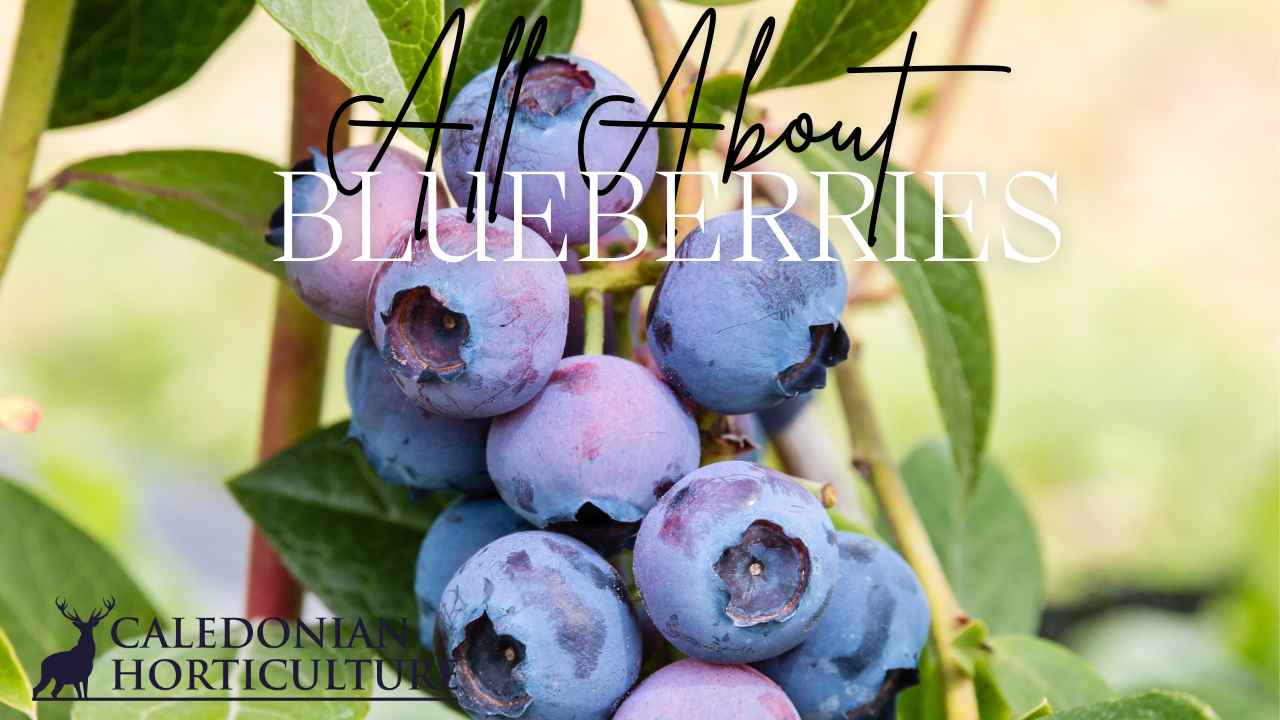Guest post by Katrina & Clayton
Blueberries are increasingly popular among gardeners in Scotland, not only for their delicious berries but also for their attractive colour changing foliage in Autumn. Thriving in acidic soils and cooler temperatures they are well suited to the Scottish climates. Blueberries can produce well in Scotland when given the right conditions and care.
Growing Blueberries in Scotland
Blueberries (Vaccinium) require a specific set of conditions to thrive, including well-drained, acidic soil and a site that receives full sun to partial shade. In Scotland’s variable climate, choosing a sheltered location can help protect blossoms from late spring frosts and ensure that your plants receive enough warmth and sunlight to ripen their fruit. The blueberry is known for its nutritional benefits, including high levels of antioxidants, vitamins C and K, and manganese.
Planting Blueberries
There are many blueberry varieties to choose from, ones that fruit at different times between early and late summer and ones that grow to different sizes from 50cm (20in) up to 2m (6½ft), so be sure to select the correct variety for your space.
Most varieties of blueberries are partly or fully self pollinating, meaning you’ll only need one plant to produce a crop. However, cross pollinated plants tend to produce larger harvests, so if you have space in your garden, plant two or preferably three different varieties.
Timing: The best time to plant blueberries is during the dormant season, from late autumn to early spring, avoiding periods when the ground is frozen.
Soil Preparation: Blueberries require acidic soil with a pH of 4.5 to 5.5. If your soil is not naturally acidic, you can amend it naturally by incorporating organic matter like well-rotted pine bark, pine needles or leaf mould that will all help to improve soil structure and drainage. Avoid well-rotted farmyard manure or mushroom compost, as they are too alkaline for blueberries.
Planting Technique: Dig a hole approximately twice as wide and the same depth as the root ball. Space plants about 1.5 to 2.5 metres apart, depending on the variety. Place the plant in the hole so that the root ball is level with the soil surface, backfill with soil, firm gently, and water thoroughly.
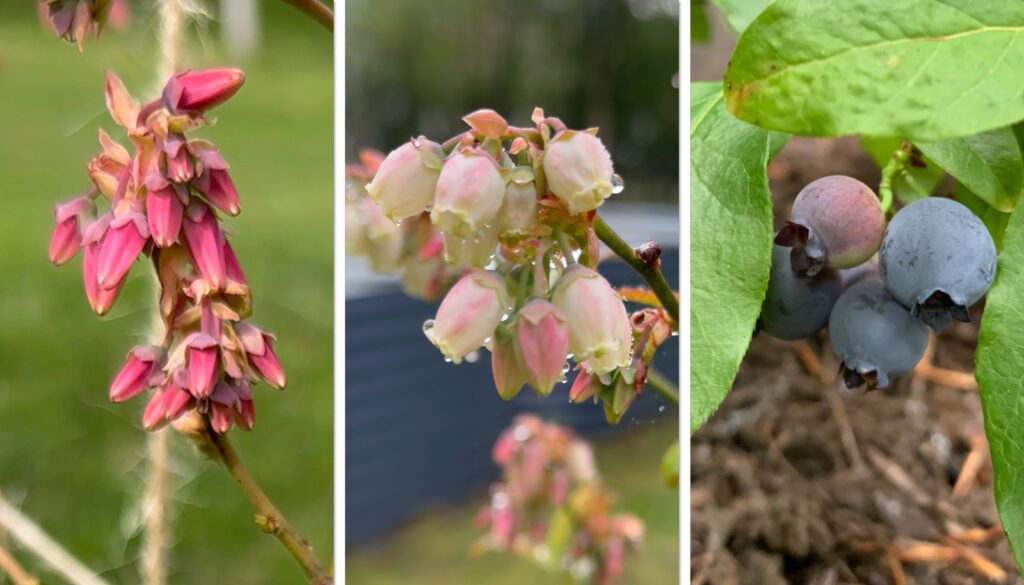
Homegrown blueberries around our garden at different stages.
Pruning Blueberries
Pruning is essential for maintaining vigorous growth and maximising fruit production. Start pruning in the second year after planting. Prune at any time from November to March, but it is easier to do in late February to early March when the fruit buds can easily be distinguished from leaf buds. Larger wider buds produce the flowers and fruit, while smaller, flatter buds form the shoots and leaves, aim to retain branches with lots of fruit buds.
Mature blueberry bushes should comprise of around:
One third old stems
One third middle-aged stems
One third young stems
Young Plants: Focus on removing any dead or damaged wood and lightly shape the plants to encourage bushy growth.
Mature Plants: Annually remove older canes (those more than four years old), any weak or broken branches, and thin out crowded areas to allow light into the centre of the bush, which helps ripen the fruit.
Dividing & Propagating Blueberries
Unlike many other fruits, blueberries are not typically divided since they grow from a central crown. However, over time, blueberry bushes can form new shoots around the base, these can be separated carefully with a spade and replanted to propagate new bushes.
Caring for Blueberries
Watering: Blueberries have relatively shallow roots and require consistent moisture to thrive and produce well, especially during dry periods. In times of flowering and fruiting it is most important to maintain the moisture levels to allow for the best fruit that season. Use rainwater from a water butt, rather than tap water, unless you have no alternative in a drought. Tap water is usually too alkaline, especially in hard water areas.
Mulching: Apply a thick layer of acidic organic mulch, such as pine needles or shredded leaves, around the base of the plants. This helps conserve moisture, suppress weeds, and gradually adds organic matter to the soil. We add leaf mulch over the winter and then some extra Caledonian Green Goodness on top around ours at the start of Spring this year as a mulch, and for enhanced water retention.
Protecting: We protect ours by placing some large mesh organza bags over them, which you can get in some supermarkets now in the fruit and veg section. They stop the birds and other pests from touching them to allow them to ripen fully, even catching them if they ripen and fall off. We just slip the bags on and off to harvest.
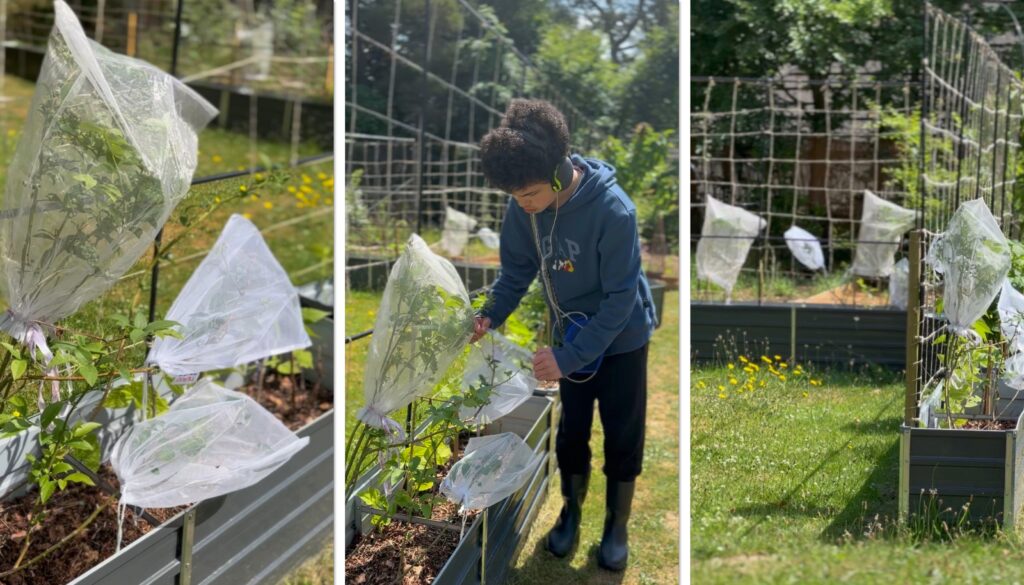
Clayton placing organza mesh bags over for protection from pests and birds.
Companion Planting
Companion planting can benefit blueberries by attracting beneficial insects, improving soil health, or deterring pests. Good companions include:
Rhododendrons, Azaleas & Camellias: These all share similar soil pH requirements and can help maintain soil acidity.
Strawberries: Can cover the ground between blueberry bushes, helping to keep weeds at bay and conserve soil moisture. We use strawberries as ground cover all through our garden.
Chives: Attract the bees for pollination and keep pests away with the smell. When grown near blueberries, chives deter Japanese beetles, deer, and aphids
Avoid planting blueberries near plants that require neutral to alkaline soil conditions, as this can lead to nutrient deficiencies.

Clayton harvesting some of our blueberries.
Optimal Soil Conditions
Planting: The ideal soil is well-drained, rich in organic matter, and acidic with a pH of 4.5 to 5.5.
Ongoing Care: Maintaining an acidic pH is crucial for blueberries. Regularly check the soil pH and amend as necessary. Organic mulches like pine needles can help maintain acidity and soil health.
For Container Grown
If you are going to grow in a container to make sure they have the correct pH soil levels then, mature blueberries need a container at least 24 inches deep and about 24-30 inches wide. When planting smaller blueberries, start with a smaller container and repot as it grows to suit. Blueberries in containers, in particular, need regular watering, even daily in hot weather.
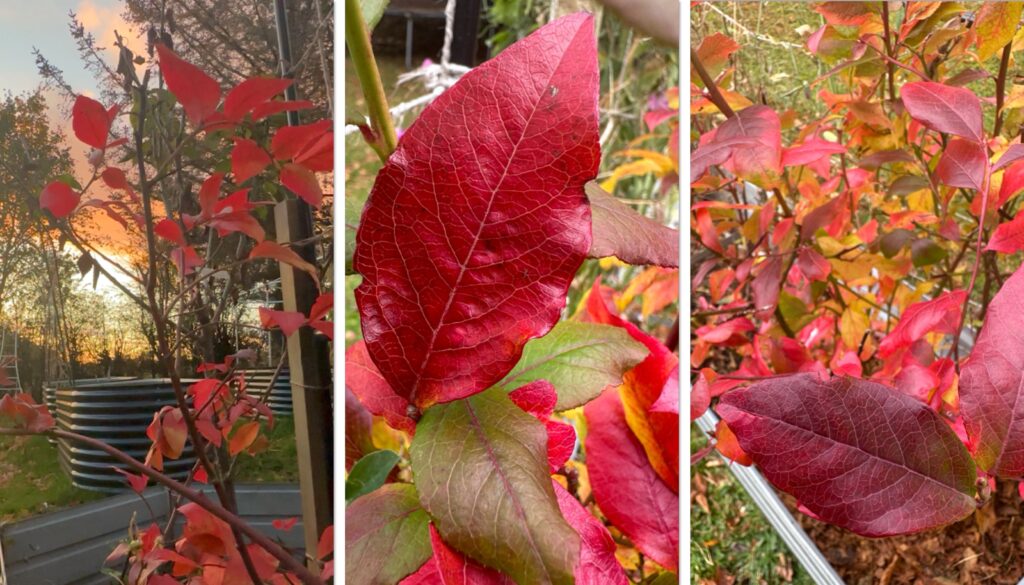
Beautiful colour changing blueberry leaf foliage in the Autumn.
Growing blueberries in Scotland can be rewarding for any gardener. Not only do you get the blueberries to eat, you get this beautiful colour changing foliage in yellow, reds and purples the Autumn months to enjoy. With attention to soil conditions, proper planting, regular care, and appropriate pruning, your blueberry bushes can become a productive and beautiful part of your garden, providing delicious fruits for many years.
Katrina & Clayton

Katrina & Clayton live with their family in East Ayrshire in Scotland and share their daily life in the garden on instagram @buildingfoodforest_scotland. They practice permaculture principles, reducing & repurposing waste whenever they can. Katrina shows how home educating in nature has helped Clayton thrive.
Clayton Completed The Grow and Learn Course with the Royal Caledonian Horticultural Society in 2022. This year he will be completing Level 2 Nurture Course. Clayton is 16, Autistic, Non Verbal & has been Home Educated for the last 6yrs. Both Katrina and husband Peter have studied the Permaculture Design Course PDC and PDC Pro over the last 5yrs, developing their garden from grass to an ongoing food forest.
They have featured on BBC Beechgrove Gardens, Gardeners World Magazine and write for Scotland Grows Magazine. Katrina has a series of children’s story books out following the life of Clayton in the garden. Available at Amazon.
See more and follow Katrina & Clayton at the links below:
-
 Builder’s Bag Green Goodness£52.00 inc VAT
Builder’s Bag Green Goodness£52.00 inc VAT -
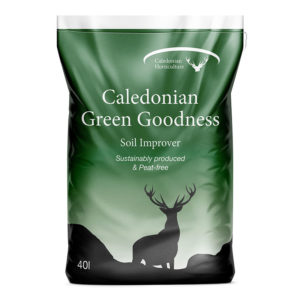 40L Green Goodness£3.50 – £4.50 inc VAT
40L Green Goodness£3.50 – £4.50 inc VAT

